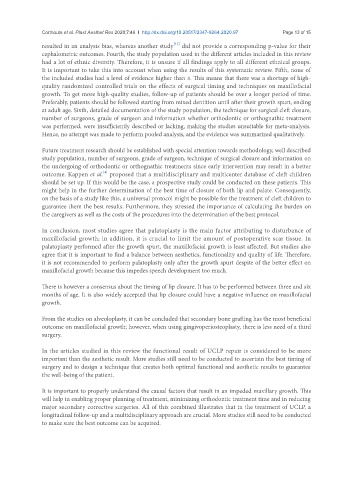Page 527 - Read Online
P. 527
Corthouts et al. Plast Aesthet Res 2020;7:46 I http://dx.doi.org/10.20517/2347-9264.2020.97 Page 13 of 15
[12]
resulted in an analysis bias, whereas another study did not provide a corresponding p-value for their
cephalometric outcomes. Fourth, the study population used in the different articles included in this review
had a lot of ethnic diversity. Therefore, it is unsure if all findings apply to all different ethnical groups.
It is important to take this into account when using the results of this systematic review. Fifth, none of
the included studies had a level of evidence higher than 3. This means that there was a shortage of high-
quality randomized controlled trials on the effects of surgical timing and techniques on maxillofacial
growth. To get more high-quality studies, follow-up of patients should be over a longer period of time.
Preferably, patients should be followed starting from mixed dentition until after their growth spurt, ending
at adult age. Sixth, detailed documentation of the study population, the technique for surgical cleft closure,
number of surgeons, grade of surgeon and information whether orthodontic or orthognathic treatment
was performed, were insufficiently described or lacking, making the studies unsuitable for meta-analysis.
Hence, no attempt was made to perform pooled analysis, and the evidence was summarized qualitatively.
Future treatment research should be established with special attention towards methodology, well described
study population, number of surgeons, grade of surgeon, technique of surgical closure and information on
the undergoing of orthodontic or orthognathic treatments since early intervention may result in a better
[4]
outcome. Kappen et al. proposed that a multidisciplinary and multicenter database of cleft children
should be set up. If this would be the case, a prospective study could be conducted on these patients. This
might help in the further determination of the best time of closure of both lip and palate. Consequently,
on the basis of a study like this, a universal protocol might be possible for the treatment of cleft children to
guarantee them the best results. Furthermore, they stressed the importance of calculating the burden on
the caregivers as well as the costs of the procedures into the determination of the best protocol.
In conclusion, most studies agree that palatoplasty is the main factor attributing to disturbance of
maxillofacial growth; in addition, it is crucial to limit the amount of postoperative scar tissue. In
palatoplasty performed after the growth spurt, the maxillofacial growth is least affected. But studies also
agree that it is important to find a balance between aesthetics, functionality and quality of life. Therefore,
it is not recommended to perform palatoplasty only after the growth spurt despite of the better effect on
maxillofacial growth because this impedes speech development too much.
There is however a consensus about the timing of lip closure. It has to be performed between three and six
months of age. It is also widely accepted that lip closure could have a negative influence on maxillofacial
growth.
From the studies on alveoloplasty, it can be concluded that secondary bone grafting has the most beneficial
outcome on maxillofacial growth; however, when using gingivoperiosteoplasty, there is less need of a third
surgery.
In the articles studied in this review the functional result of UCLP repair is considered to be more
important than the aesthetic result. More studies still need to be conducted to ascertain the best timing of
surgery and to design a technique that creates both optimal functional and aesthetic results to guarantee
the well-being of the patient.
It is important to properly understand the causal factors that result in an impeded maxillary growth. This
will help in enabling proper planning of treatment, minimizing orthodontic treatment time and in reducing
major secondary corrective surgeries. All of this combined illustrates that in the treatment of UCLP, a
longitudinal follow-up and a multidisciplinary approach are crucial. More studies still need to be conducted
to make sure the best outcome can be acquired.

